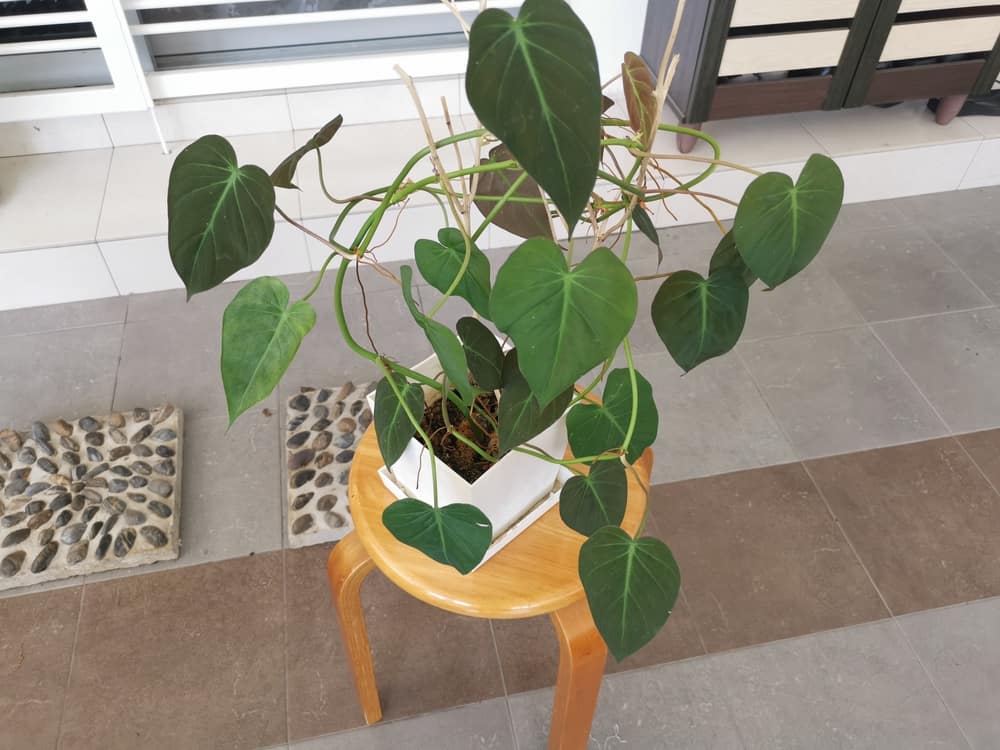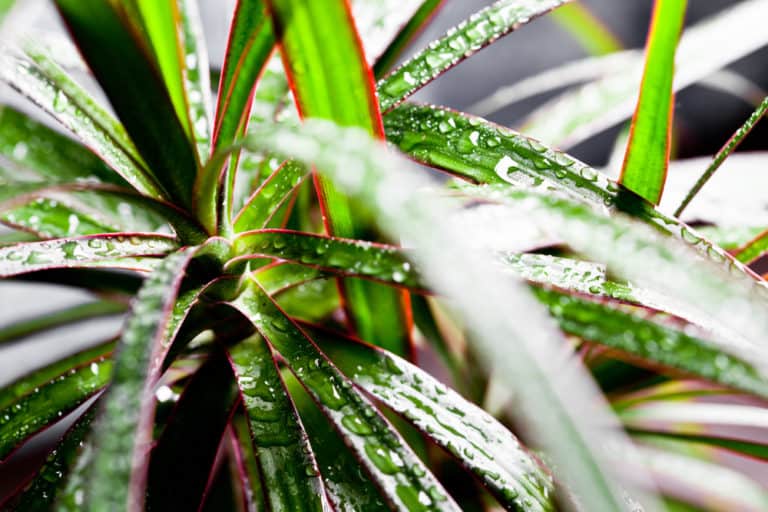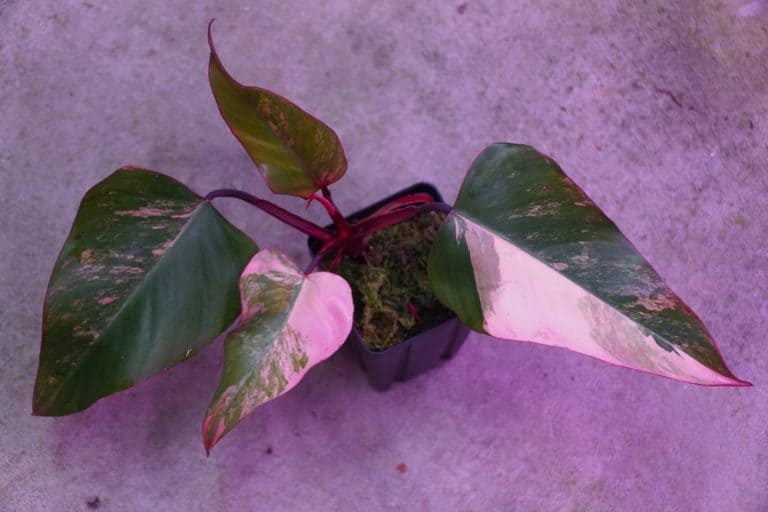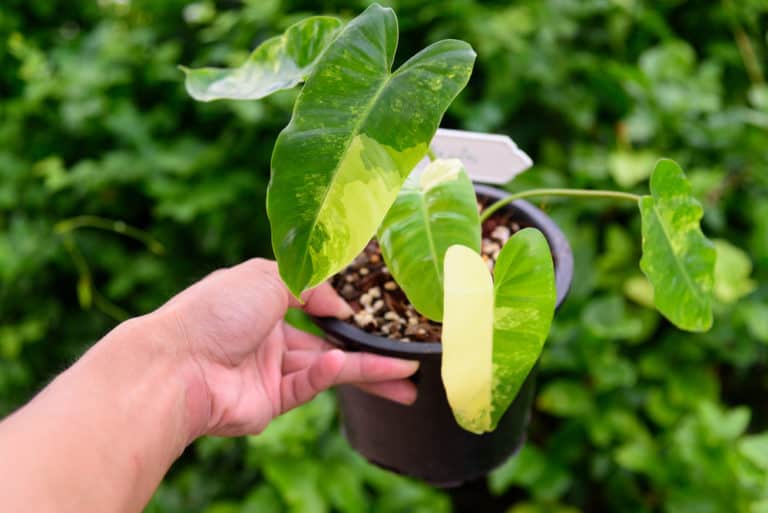Philodendron Micans ‘Velvet Leaf’ Care Guide (2024)

Philodendron micans is a beautiful tropical plant that is much in demand as a houseplant.
As you might guess from its common name velvet leaf Philodendron, it features gorgeous leaves with a velvety texture.
Fast-growing and easy to keep happy, it’s a plant that even beginners can grow with ease.
| Scientific Name | Philodendron hederaceum var. hederaceum |
| Common Name | Velvet Leaf Philodendron, Philodendron micans, Sweetheart Plant |
| Light | Bright indirect sunlight |
| Watering | Weekly, water if the top two inches of soil are dry |
| Temperature | 65 – 85°F (18 – 30°C) |
| Hardiness Zone | 10a, 10b, 11a, 11b |
| Humidity | 50 – 80% |
| Soil Type | Quick-draining, rich |
| Soil pH | 5 to 6.5 (mildly acidic) |
| Fertilizing | A balanced feed once a month in spring and summer |
| Repotting | Every 1 to 3 years |
| Pruning | During the growing season |
| Propagation | Root in water or soil |
| Toxicity | Toxic to humans and pets |
| Mature Size | 8 inches tall, 4 feet long |
| Bloom Time | Rarely blooms indoors |
What’s Unique About Philodendron micans?
Philodendron micans plants are native to the islands of Dominica and Tobago in the Caribbean, where they grow in the tropical rainforests.
The beautiful foliage of the Philodendron micans plant has made it one of the darlings of the indoor garden world.
The heart-shaped velvety leaves of philo micans change from chartreuse to deep green as they mature, with rich red undersides.
The micans plant is also very well-suited to growing in a hanging basket, so is perfect when your floor space is limited.
Growing Philodendron micans is very easy; if you can provide it with conditions similar to the rainforests where it originates, it will thrive.
Philodendron micans Care
Good Philodendron micans plant care is as simple as giving it a spot where it can enjoy the same growing conditions as in its native home.
Your velvet leaf Philodendron care will be successful if you keep it in a warm, humid environment in indirect light and with good soil drainage.
Light
Philodendron micans light requirements derive from its native environment in the tropical rainforest, where it grows in the dappled shade cast by the tree canopy.
Thus, velvet leaf Philodendron light needs are for bright, indirect light, or between 10,000 to 20,000 lux.
It will not tolerate full sun, so if you only have a south or west exposure, position your Philodendron micans several feet away from the windows. When you have no other space, a light curtain can shade it from the punishing rays.
However, you can put it close to a north or east window, where the morning sun will not damage your Philodendron micans.
Watering
While Philodendron micans is used to moist soil in its rainforest home, the soil there is also porous and drains away any excess water.
As a result, the watering needs for Philodendron micans are for frequent enough watering to keep the soil moist, without ever letting it get soaked.
Philodendron micans watering should be done whenever the top couple of inches have dried out.
Gently soak the surface with the water, and repeat until you see water draining out the bottom. Let all the excess water drain away before putting the pot back in its saucer.
Water velvet leaf Philodendron with distilled or rain water, as the salts and chemicals in tap water can harm the plant over time.
Temperature
The ideal Philodendron micans temperature range is 65-85°F (18-30°C).
Luckily, the lower part of that range is typical for indoor heating in temperate regions. Almost any indoor temperature that works for you is a good temperature for velvet leaf Philodendron.
However, while it won’t mind temperatures as low as 55°F (12°C) at night, its temperature tolerance falls off drastically below 50°F (10°C). Even sitting in a draft or near an air conditioning vent can damage your Philodendron micans.
If you move it outside in summer, bring it in before nighttime temperatures get too low.
Velvet leaf Philodendron has absolutely no frost hardiness. Exposure to freezing temperatures will kill it outright.
Humidity
Philodendron micans humidity requirements have some flexibility. While the ideal humidity for velvet leaf Philodendron is around 70% or more, it will tolerate a lower humidity level.
You can get away with humidity as low as 40%, for which you may not need to use any supplemental methods to raise levels for your velvet leaf Philodendron.
However, if your air gets drier than that, or you want to see some really impressive leaves on your Philodendron micans, you have some options.
You can mist the leaves daily with a fine sprayer and distilled water, or group all your tropicals together and use a small humidifier to add moisture to the air.
Soil
Philodendron micans soil needs to retain some water, while at the same time being porous enough to let the roots breathe. You can use standard potting soil, but adding some extras will make it even better.
The best soil for velvet leaf Philodendron has organic matter to feed the plant for optimal foliage growth. Incorporate a scoop of well-rotted compost or worm castings to your soil mix.
Aim for a pH level for velvet leaf Philodendron of 5 to 6.5 (mildly acidic). This can easily be achieved by adding some peat moss to the soil mix.
You can also never go wrong with some extra perlite, which will lighten the soil even more.
Fertilizer
If you added compost or slow-release granules to the soil when you potted your Philodendron micans, your fertilizing is already done for you.
However, you will otherwise need to use fertilizer for velvet leaf Philodendron on a regular basis to ensure strong, healthy growth.
A standard indoor liquid formula with a fertilizer ratio of 10-10-10 will make a good Philodendron micans fertilizer.
Dilute it to half strength to avoid burning the roots, and use it once a month during spring and summer.
Always apply it to the soil, not the leaves, and do so right after you’ve watered to ensure even distribution.
Potting & Repotting
Philodendron micans repotting is necessary every 2 or 3 years, when it starts to outgrow its current pot.
You will know when it’s time for repotting velvet leaf Philodendron when it becomes rootbound. Roots start to grow out of the drainage holes, and if you lift the root ball out of the pot you will see the roots take up most of the pot with little room for soil.
Just move up one pot size, or at most 2 inches in diameter, as too much soil will actually stress the plant. Use an unglazed clay pot and make sure it has good drainage holes.
Always use fresh soil when potting on your Philodendron micans.
Pruning
Philodendron micans pruning should be done on a fairly regular basis to keep this fast-growing perennial looking its best.
As always, remove dead or damaged leaves whenever you see them, as they can harbor disease and mar the good looks of your Philodendron micans.
In the spring or summer, you can cut out straggly stems to encourage bushier growth. Trim the longest stems right above a node (or below if you’re growing it as a hanging plant).
Never cut off more than 25% of the foliage in any one growing season.
When cutting velvet leaf Philodendron, use sharp, sterilized scissors.
Propagation
Philodendron micans propagation is incredibly easy, with a high success rate even for beginners.
The best way to propagate velvet leaf Philodendron is by rooting stem cuttings in water.
Select healthy stems with at least 4 nodes. Cut the stem just below the lowest node. Remove all but a few leaves at the tip.
Put the stems in filtered water, keeping a few nodes submerged. Place the jar out of the direct sun in a warm spot. Change the water every few days when it starts to look cloudy.
In a few weeks you should see roots developing. Plant each baby Philodendron micans out in its own pot.
Also, make sure to check out our in-depth Philodendron moonlight care guide.
Common Problems of Philodendron micans
You will not have many problems with velvet leaf Philodendron, but you do have a few things to look out for.
Luckily, Philodendron micans problems can be easily resolved, and most can be prevented with the appropriate growing conditions.
The leaves will usually let you know if something is amiss, so keep a close eye on them.
Pests
Velvet leaf Philodendron is susceptible to attacks by many of the bugs that commonly infest house plants.
Spider mites may spin sticky webs, and leave white or yellow spots on the tops of the leaves.
Aphids are small, greenish insects found on the underside of the leaves.
Use a hand-held shower or sink nozzle to remove both spider mites and aphids.
Mealybugs look like little cotton puffs on the underside of leaves. A cotton ball soaked in rubbing alcohol will wipe them off.
Scale look like brown bumps, usually on the stems.Scrape them off.
You can prevent Philodendron micans pests from returning by using insecticidal soap or neem oil sprays.
Diseases
Most Philodendron micans diseases can be prevented before they get established. If you keep the soil moist but never sopping wet, fungal and bacterial diseases are less likely to take hold.
Erwinia Blight is a bacterial disease. If your velvet leaf Philodendron gets this, you will see mushy dark patches develop on the leaves.
Cut off all infected parts and repot your Philodendron micans in fresh soil after thoroughly disinfecting its pot inside and out.
Root Rot is a fungal disease that results in yellowing leaves and mushy stems. Pull the root ball out and trim off the blackened roots and dying foliage. Replant in fresh soil.
Growing Problems
Sometimes what appears to be a sick plant just needs an adjustment. When your Philodendron micans gets the right conditions, most growing problems will go away.
Leaves curling under are a sign that your Philodendron micans needs more water. Give it a thorough soaking and then let all excess water drain out.
On the other hand, yellowing leaves are a sign of too much water. Cut back on your watering frequency.
If the edges of the leaves are getting brown and crispy, there’s not enough humidity for your Philodendron micans.
If the leaves are growing far apart on the stems, you should move your Philodendron micans to a spot with brighter light.
Toxicity of Philodendron micans
Velvet leaf Philodendron is a member of the araceae family, and therefore is toxic to all animals, including humans and pets.
Its toxicity is caused by the calcium oxalate crystals that can be found in all parts of the plant.
While you can still use it in your home, you should take precautions to prevent exposure.
For Humans
Philodendron micans is toxic to humans, although a life-threatening reaction to calcium oxalate is unlikely.
However, you should certainly exercise care in a home with children, and be aware of how to treat any exposure to the toxin.
Unless you ingest any of the foliage, your only risk is a skin irritation from the sap. Rinse it off with soap and water.
Children might try eating a leaf, which can cause pain and swelling around their mouth. Clean all traces off, and give them something cool and soothing to eat.
However, if their tongue becomes swollen or their throat swells up, take them to the emergency room as soon as possible.
For Pets
All household pets can be affected by ingesting Philodendron micans foliage. Even birds are at risk from the toxins in the plant.
If your pet starts drooling excessively, or experiences vomiting and diarrhea, take it in for veterinary attention immediately. Calcium oxalate can cause long-term damage to the kidneys.
It’s best to prevent such a scenario by keeping your Philodendron micans out of reach of small household members.
Velvet leaf Philodendron is a prime candidate for growing in a hanging planter or on a high shelf where its tendrils will trail down. Keep them trimmed to a safe distance from the floor.
Philodendron micans Appearance
Velvet leaf Philodendron is a gorgeous plant that often turns up in Instagram posts because of its attractiveness.
The beautiful Philodendron micans appearance is largely because of its velvety leaves that cascade down from a planter or climb up a pole.
It’s compact enough to fit into even a small space where a touch of the tropics is desired.
Foliage
The foliage of Philodendron micans is lush and luxurious.
When each leaf unfurls it is bright green or chartreuse, with a thin edging of pink. As they mature, the heart-shaped leaves turn a deep bronze green on top, with a pink or red underside.
When the light shines through them they seem almost iridescent.
When fully grown, a Velvet leaf Philodendron leaf will be up to 3 inches across and 4 inches in length.
The other notable quality of Velvet leaf Philodendron’s leaves is, of course, their velvety texture. Because of this, it is not recommended to wipe down the leaves as is the case with other philodendrons.
Flowering
While Philodendron micans flowering is possible, a velvet leaf Philodendron flower is never going to equal the beauty of its foliage.
In fact, the flowers are insignificant white and green spathes with no scent.
So, it’s not a big problem that blooming rarely occurs when Velvet leaf Philodendron is grown as a potted plant indoors.
It’s only really likely if you live in a tropical region and can grow your Philodendron micans outdoors planted in the ground.
Instead, enjoy the gorgeous leaves of this tropical plant, as the variety of color as leaves unfurl and mature is more than enough to satisfy the eye.
Size and Growth
Grown indoors, the mature size of Philodendron micans is about 8 inches tall, but with trailing stems to about 4 feet. If it is trained up a post you can expect about the same height upwards.
It has a growth rate of about a foot a year.
If grown outdoors in a tropical zone where it can be planted in the ground, Philodendron micans can reach as much as 8 feet. It will happily climb up a tree trunk, as it prefers a shady spot anyway.
Indoors, you can train your Velvet leaf Philodendron up a sphagnum moss pole, or let it trail out of a hanging planter or a pot on a high shelf.
Philodendron micans Fragrance
There is no Philodendron micans fragrance. Neither the evergreen foliage nor the rare flowers have any discernible scent.
On the other hand, Velvet leaf Philodendron is effective at filtering contaminants such as formaldehyde and benzene from the indoor air.
So even though it has no fragrance, it does make your home’s environment better to breathe.
Scentless plants such as Velvet leaf Philodendron are good in small spaces like studio apartments. In such confined quarters, a strong fragrance could easily be overwhelming.
They’re also preferred in establishments such as nursing homes and hospitals, where people with fragrance allergies need to be considered.
Suggested Uses for Philodendron micans
Velvet leaf Philodendron has become a very popular house plant in the Instagram and pandemic age. People have been looking for ways to enhance their homes as they spend more time indoors.
Philodendron micans is such a versatile plant that it can fit into a small apartment or a sprawling home with equal ease.
In a shady corner, you can hang a planter with Philodendron micans foliage spilling down to create a soft and tropical touch.
In summer, moving a staked Velvet leaf Philodendron out to a patio can make it a more welcoming living space.
In a spa or large bathroom, a Philodendron micans can benefit from the added humidity and soften the look of the hard surfaces.
FAQ
What is Philodendron micans?
Philodendron micans is a tropical evergreen plant native to the rainforests of Dominica and Tobago. It is grown as a houseplant for its attractive foliage.
How to identify Philodendron micans?
Philodendron micans has heart-shaped leaves with a velvety surface. The leaves range from chartreuse to deep green with a pink or red underside. It can be trailing or climbing.
How to care for Philodendron micans?
Philodendron micans should be kept out of the direct sun in a warm, moderately humid environment, with regular watering to keep the soil evenly moist.
How to grow Philodendron micans indoors?
Philodendron micans can be grown as a potted plant trailing from a hanging planter or high pot, or climbing up a pole, and kept out of full sun.
How to grow Philodendron micans outdoors?
Philodendron micans can be grown outdoors year-round in a tropical region. Plant in rich, well-draining soil in the shade of a tree that it can climb.
How fast does Philodendron micans grow?
Philodendron micans has a moderately fast growth rate, growing about a foot a year in spring and summer. It does not usually put out new growth in winter.
How tall does Philodendron micans grow?
When grown as a trailing plant, Philodendron micans plants grow to a height of 8 inches, with trailing stems up to 4 feet in length.
How to make Philodendron micans grow faster?
Philodendron micans will grow its fastest when it is given the ideal tropical conditions of consistently moist soil, heat, and high humidity, with regular light fertilizing.
How to stake Philodendron micans?
Philodendron micans can be staked with a sphagnum moss pole and trained as a climbing vine. It can also be planted in a hanging basket and allowed to trail.
How to pot Philodendron micans?
Philodendron micans should be potted in an unglazed clay pot, in a loose potting mix that will retain moderate moisture while not becoming saturated with water.
How to revive Philodendron micans?
If your Philodendron micans soil has dried out, take the entire pot and submerge it in water until it becomes wet through. Then let all excess water drain.
Why is my Philodendron micans dying?
Your Philodendron micans may have a fungal or bacterial disease because you have kept its soil too wet. Cut out all affected parts and replant in fresh soil.
Why is my Philodendron micans drooping?
Your Philodendron micans may have insufficient soil moisture. Slowly and carefully water the soil several times until excess water runs out the bottom drainage holes.
How cold can Philodendron micans tolerate?
Philodendron micans can tolerate temperatures as low as 55°F (12°C), but anything below that can damage the plant, and they will be killed by freezing temperatures.
How to get rid of pests on Philodendron micans?
To prevent pests on your Philodendron micans, use organic insecticidal soap and neem oil sprays to kill existing insects and discourage new infestations from occurring.
Is Philodendron micans toxic to cats?
Yes, Philodendron micans is toxic to cats. If your cat starts drooling or vomiting, you need to take it to the veterinarian immediately to prevent permanent damage.
Is Philodendron micans toxic to dogs?
Yes, Philodendron micans is toxic to dogs. If your dog develops vomiting or diarrhea, or starts drooling or wheezing, it needs immediate attention from a veterinarian.
Is Philodendron micans toxic to children?
Yes, Philodendron micans is toxic to children. If your child ingests any foliage and develops a swollen tongue or has difficulty breathing, take them to the emergency room.
Is Philodendron micans toxic to humans?
Yes, Philodendron micans is toxic to humans. Exposure to the sap can sometimes cause an irritation or rash. Rinse it off with soap and water.
Does Philodendron micans have a scent?
No, Philodendron micans has no scent. Both the foliage and rare flowers are fragrance-free. This makes it suitable for use in environments where strong scents are not allowed.






